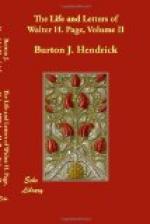VOLUME II
Chapter
page
XIV.
The “Lusitania” And after
1
XV.
The ambassador and the lawyers
53
XVI.
Dark days for the allies
81
XVII. Christmas
in England, 1915 103
XVIII. A perplexed
ambassador 128
XIX.
Washington in the summer of
1916 148
XX.
“Peace without victory”
189
XXI.
The united states at war
215
XXII. The
Balfour mission to the united
states 248
XXIII. Page—the
man 295
XXIV. A respite
at st. Ives 321
XXV.
Getting the American troops to
France 349
XXVI. Last
days in England
374
XXVII. The
end 404
appendix
407
Index
425
LIST OF ILLUSTRATIONS
Sir Edward Grey Frontispiece
Facingpage
Col. Edward M. House.
From a painting by P.A.
Laszlo
88
The Rt. Hon. Herbert Henry
Asquith, Prime Minister
of Great Britain, 1908-1916
89
Herbert C. Hoover, in 1914 104
A facsimile page from the Ambassador’s
letter of
November 24, 1916, resigning his Ambassadorship
105
Walter H. Page, at the
time of America’s entry into
the war, April, 1917
216
Resolution passed by
the two Houses of Parliament,
April 18, 1917, on America’s
entry into the war 217
The Rt. Hon. David
Lloyd George, Prime Minister
of Great Britain, 1916—
232
The Rt. Hon. Arthur
James Balfour (now the Earl of
Balfour), Secretary
of State for Foreign Affairs,
1916-1919
233
Lord Robert Cecil, Minister
of Blockade, 1916-1918,
Assistant Secretary
of State for Foreign Affairs,
1918
344
General John J. Pershing,
Commander-in-Chief of
the American Expeditionary
Force in the Great
War
345




